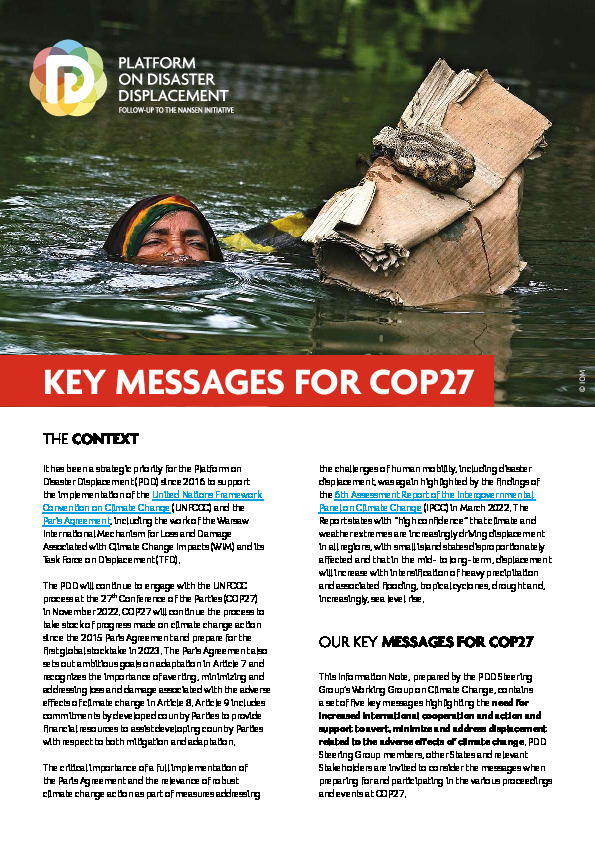Platform on Disaster Displacement
Key Messages for the 2022 United Nations Climate Change Conference – COP27
Increasing International Cooperation, Action and Support to Better Avert, Minimize and Address Displacement Related to the Adverse Effects of Climate Change
THE CONTEXT
It has been a strategic priority for the PDD since 2016 to support the implementation of the United Nations Framework Convention on Climate Change (UNFCCC) and the Paris Agreement, including the work of the Warsaw International Mechanism for Loss and Damage Associated with Climate Change Impacts (WIM) and its Task Force on Displacement (TFD).
The PDD will continue to engage with the UNFCCC process at the 27th Conference of the Parties (COP27) of the UNFCCC in November 2022. COP27 will continue the process to take stock of progress made on climate change action since the 2015 Paris Agreement and prepare for the first global stocktake in 2023. The Paris Agreement also sets out ambitious goals on adaptation in Article 7 and recognizes the importance of averting, minimizing and addressing loss and damage associated with the adverse effects of climate change in Article 8. Article 9 includes commitments by developed country Parties to provide financial resources to assist developing country Parties with respect to both mitigation and adaptation.
The critical importance of a full implementation of the Paris Agreement and the relevance of robust climate change action as part of measures addressing the challenges of human mobility, including disaster displacement, was again highlighted by the findings of the 6th Assessment Report of the Intergovernmental Panel on Climate Change (IPCC) in March 2022. The Report states with “high confidence” that climate and weather extremes are increasingly driving displacement in all regions, with small island states disproportionately affected and that in the mid- to long-term, displacement will increase with intensification of heavy precipitation and associated flooding, tropical cyclones, drought and, increasingly, sea level rise.
Previously, by IPCC Working Group I and the first installment of the 6th Assessment Report, the IPCC has described a climate emergency and it has projected increased climate change-related risks across all regions. According to the IPCC findings, global warming is happening faster than previously predicted, and the report concluded that “unless there are immediate, rapid and large-scale reductions in greenhouse gas emissions, limiting warming to close to 1.5°C or even 2°C will soon be beyond reach.”
Climate change and its disastrous effects have become our constant companion, our constant threat, and our constant worry. It’s time to turn things around. We know where we are falling short. And we know how to correct the current course we are on.” – Simon Stiell, UNFCCC Executive Secretary
OUR KEY MESSAGES FOR COP27
In the context of the climate emergency and the ongoing and growing displacement trends related to the adverse effects of climate change, this draft Information Note, prepared by the PDD Steering Group’s Working Group on Climate Change, contains a set of five broad key messages highlighting the need for increased international cooperation and action and support to avert, minimize and address displacement related to the adverse effects of climate change. PDD Steering Group members, other States and all relevant Stakeholders are invited to consider the messages and use them as they deem appropriate when preparing for and participating in the various proceedings and events at COP27.
1. When Taking Action to Address the Adverse Effects of Climate Change, Including Disaster Displacement and Migration, Respect, Promote and Protect Human Rights and Ensure the Participation and Effective Representation of Affected Communities
- Parties to the Paris Agreement commit, in its preamble to respect, promote and consider their respective obligations on human rights when taking action to address the adverse effects of climate change. A human rights-based approach to climate change action can support increased ambitions and action to mitigate emissions and ensure more effective and inclusive adaptation measures.
- The application of human rights standards and principles such as participation, accountability and non-discrimination will strengthen the effectiveness of climate change action, including to avert, minimize and address loss and damage related to the adverse effects of climate change, be they economic or non-economic (e.g. loss of cultural heritage, loss of biodiversity and displacement).
- Applying a human rights based approach when integrating displacement considerations in climate action means:
- The inclusion and active participation in climate change action and decision-making processes of persons most at risk of the adverse effects of climate change and displacement due to characteristics related to age, gender or diversity and other circumstances exacerbating vulnerability.
- The effective representation, consultation and participation of people and communities adversely affected by climate change when making decisions and developing policies at the global, regional and national level.
- The integration of human rights obligations and other relevant international standards and legal considerations when formulating laws, policies and strategies, to avert, minimize and address displacement related to the adverse impacts of climate change.
2. Scale Up Action and Support to Address Adverse Drivers of Migration and Avert, Minimize and Address Displacement Related to the Impacts of Climate Change
- One of the most challenging consequences of a changing climate is the increase in frequency and intensity of weather and climate-related events and processes, and their impact on displacement. Millions of people are forcibly displaced, mainly within their own countries, as a result of disasters linked to natural hazards. In the absence of immediate action to combat climate change and build climate and disaster resilient systems, more people will be compelled to move in the future.
- Many countries, especially those that are particularly vulnerable to the adverse effects of climate change – such as Small Island Developing States (SIDS) and Least Developed Countries (LDCs), are already reaching the point at which existing approaches to climate change adaptation and disaster risk reduction prove insufficient without stronger commitments to address climate change (“hard adaption limits”). According to the latest findings of the IPCC, many human and natural systems are near the limits of their adaptation capacity and additional human and natural systems will reach their adaptation limits with increasing global warming.
- To scale up action and support to avert, minimize and address displacement related to the adverse impacts of climate change means:
- Ensuring full implementation of the 2015 Paris Agreement’s temperature goal.
- Addressing adaptation gaps and increasing ambitions National Adaptation Plans (NAPs), and step up actions to reach the adaptation goals of the Paris Agreement.
- Increasing ambitions in Nationally Determined Contributions (NDCs).
- Enhancing capacities of all countries to address underlying drivers of risk, develop risk models, invest in risk reduction and adaptation measures, prepare for future disasters, and respond to shocks and stresses, including by addressing their human mobility implications.
- Addressing the protection and assistance needs of people on the move in the context of the adverse effects of climate change, including developing durable solutions that anticipate future climate impacts and ensuring that DRR is mainstreamed in humanitarian policy and action.
- Translating globally recognized policy priorities and recommendations into effective measures requires adopting context-specific approaches that are adapted to local hazard and risk profiles and human mobility patterns.
- Effective efforts build on research and data collection on disaster displacement, and assessments of future occurrence and patterns of displacement in the context of climate change.
- They need to result in displacement considerations being integrated into all long-term development, adaptation and land-use policies, plans and investments, as well as into emergency preparedness and anticipatory action.
- They need to be supported by stronger capacities and more diverse opportunities for accessing climate finance by countries acutely affected by, and at risk to, the impacts of climate change.
3. Recall and Reiterate the Relevance of the WIM Executive Committee Recommendations on Integrated Approaches to Avert, Minimize and Address Displacement Related to the Adverse Effects of Climate Change
- COP24 (December 2018) in Katowice, Poland, welcomed the recommendations of the Executive Committee of the WIM based on the work of the TFD. The 2018 Recommendations:
- Cover a wide range of actions to be taken by Parties and other stakeholders to better understand and address climate-related displacement risk and to be better prepared to respond to disaster displacement challenges;
- Include measures to facilitate migration or planned relocation as ways to adapt to the adverse effects of climate change.
- Acknowledging that climate change results into increasing numbers of people moving, whether to save their lives, or cope with and anticipate its adverse impacts, it is recommended to scale up efforts at implementing the 2018 Recommendations, by:
- Recalling the relevance and importance of the 2018 Recommendations on integrated approaches to averting, minimizing and addressing displacement related to the adverse impacts of climate change from the Executive Committee of the WIM (10/CP.24).
- Encouraging further engagement and support of Parties and other stakeholders for the plan of action of the TFD 2022-2024 and work on human mobility under strategic workstream (d) of the new five-year rolling workplan of the WIM.
4. Support further Operationalization and Development of the Institutional Arrangements of the Santiago Network for Loss and Damage
- The Santiago Network for Loss and Damage (SNLD) was established during the Climate Change Conference in 2019 (COP25), as part of the WIM.
- The functions of the SNLD were decided at COP26.
- The objective of the SNLD is to catalyze the technical assistance of relevant organizations, bodies, networks and experts for the implementation of relevant approaches at the local, national and regional levels in developing countries that are particularly vulnerable to the adverse effects of climate change.
- The effective operationalization of the SNLD represents an important opportunity for increased action and support, better coordination and enhanced policy coherence, both under and outside of the UNFCCC.
- The effective operationalization of the SNLD can be supported by:
- Making resources and funds available for the operation of the SNLD in order for it to discharge its functions, develop institutional arrangements and catalyze relevant technical assistance.
- Making resources available for technical assistance for the implementation of relevant approaches to avert, minimize and address loss and damage, including displacement, in developing countries particularly vulnerable to the adverse effects of climate change.
- Engage in and support the Glasgow Dialogue on arrangements for the funding of activities to avert, minimize and address loss and damage.
- Promote the development and use of technical papers, case studies, specific examples and guidelines to assist catalyzing technical assistance through the SNLD
- Encouraging organizations, networks and experts working on human mobility to join and support the SNLD, as appropriate.
5. Increase Access to Sustainable and Predictable Climate Financing to Avert, Minimize and Address Displacement Related to the Adverse Impacts of Climate Change
- More climate finance is needed for mitigation and adaptation, included for activities that avert, minimize and address loss and damage.
- There is a need to promote the design and implementation of new, innovative and people-centered approaches, including climate and disaster risk finance and insurance, and to support developing countries to access finance to address climate change-related displacement challenges comprehensively and effectively.
- Increasing access to sustainable and predictable financing to avert, minimize and address displacement related to the adverse impacts of climate change means:
- Action and support for mitigation, adaptation and loss and damage in support to developing countries which are particularly vulnerable to climate change;
- Facilitating and increasing access to funding for the development of proposals related to the workplan of the WIM and the TFD Plan of Action;
- Recognizing the urgent need to scale up action and support, mobilize resources and develop innovative financing mechanisms from both public, private and alternative sources to build resilient systems and implement integrated, effective, risk-informed and human rights-based approaches to displacement related to the adverse impacts of climate change.
Cover photo: © IOM






